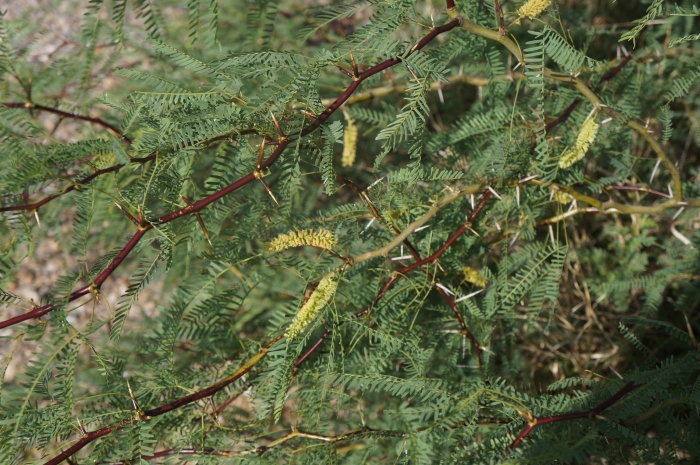Western Honey Mesquite
(Prosopis glandulosa var. torreyana)
Western Honey Mesquite (Prosopis glandulosa var. torreyana)
/
/

Henggang Cui
Public Domain
Image By:
Henggang Cui
Recorded By:
Copyright:
Public Domain
Copyright Notice:
Photo by: Henggang Cui | License Type: Public Domain | License URL: http://creativecommons.org/publicdomain/zero/1.0/ | Rights Holder: Henggang Cui | Publisher: iNaturalist | Date Created: 2019-04-02T10:57:35-07:00 |


















































Estimated Native Range
Summary
Prosopis glandulosa var. torreyana, commonly known as Western Honey Mesquite, is a deciduous tree or large shrub native to arid and semi-arid regions, including desert grasslands, scrublands, and riparian zones in the Southwestern United States and Northwestern Mexico. It typically grows to a height of 15-35 feet (5-11 meters) and a width of 10-20 feet (3-6.1 meters). The Western Honey Mesquite is characterized by its twisted trunks, deep taproots, and a broad, spreading canopy. It produces creamy-yellow flowers in long, cylindrical spikes during the spring and summer, which are highly attractive to bees and other pollinators. The tree also bears long, flat seed pods that are edible and have been a traditional food source for indigenous peoples.
Western Honey Mesquite is valued for its adaptability to harsh environments, its ability to fix nitrogen in the soil, and its use as a shade tree in hot climates. It is often used for erosion control, as a windbreak, and in reclamation projects. In cultivation, it requires minimal water once established, thrives in full sun, and is tolerant of a wide range of soil types, although it prefers well-drained soils. It is also used for its hardwood, which is prized for furniture and barbecue smoking. However, gardeners should be cautious as it can become invasive outside its native range, and its thorns can be problematic. Additionally, it is susceptible to a fungal disease called Texas root rot in poorly drained soils.CC BY-SA 4.0
Western Honey Mesquite is valued for its adaptability to harsh environments, its ability to fix nitrogen in the soil, and its use as a shade tree in hot climates. It is often used for erosion control, as a windbreak, and in reclamation projects. In cultivation, it requires minimal water once established, thrives in full sun, and is tolerant of a wide range of soil types, although it prefers well-drained soils. It is also used for its hardwood, which is prized for furniture and barbecue smoking. However, gardeners should be cautious as it can become invasive outside its native range, and its thorns can be problematic. Additionally, it is susceptible to a fungal disease called Texas root rot in poorly drained soils.CC BY-SA 4.0
Plant Description
- Plant Type: Tree, Shrub
- Height: 15-35 feet
- Width: 10-20 feet
- Growth Rate: Moderate
- Flower Color: Yellow
- Flowering Season: Spring, Summer
- Leaf Retention: Deciduous
Growth Requirements
- Sun: Full Sun
- Water: Low
- Drainage: Fast
Common Uses
Bee Garden, Bird Garden, Butterfly Garden, Fragrant, Low Maintenance, Street Planting
Natural Habitat
Native to arid and semi-arid regions, including desert grasslands, scrublands, and riparian zones
Other Names
Common Names: Honey Mesquite, Heuningprosopis, Mesquite
Scientific Names: , Prosopis glandulosa var. torreyana, Prosopis glandulosa subsp. torreyana, Prosopis juliflora var. torreyana,
GBIF Accepted Name: Prosopis glandulosa var. torreyana (L.D.Benson) M.C.Johnst.